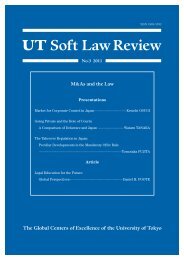UT Soft Law Review
UT Soft Law Review
UT Soft Law Review
You also want an ePaper? Increase the reach of your titles
YUMPU automatically turns print PDFs into web optimized ePapers that Google loves.
<strong>UT</strong> <strong>Soft</strong> <strong>Law</strong> <strong>Review</strong> No.2 2010us?Ishiwata: First, we should consider why takeover defense plans have been adopted since2005. One of the reasons is the hostile takeover case of Nippon Broadcasting System byLivedoor in 2005. This case made people realize that hostile takeover could actually happen inJapan. Then, in 2005, the guidelines regarding takeover defense were issued by the Ministryof Economy, Trade and Industry and Ministry of Justice so that the requirements for acompany to adopt takeover defense plans legally were clarified. We can point out that thisexpanded the people’s awareness that they can adopt takeover defense plans legally. Also,Japanese TOB regulations basically allow an acquisition through accumulation in the stockmarket and basically permits partial acquisitions with very limited coverage of the obligationto purchase all shares (i.e. the mandatory purchase rule); therefore, it can be pointed out thatour legal system offers an environment where a takeover can be easily concluded.Next, as for the question of how to interpret the number 570, I believe that this is withinmy expectations. The number of domestic listed companies in Japan is said to be about 3,870,and 14.7% of them have adopted defense plans. Although this figure is small compared to thatof the U.S., most Japanese companies who adopt takeover defense plans obtain approval atthe shareholders’ meeting in advance, so it requires more procedures than in the U.S. It isalso well known even in Japan that, recently, increasing numbers of companies haveabandoned takeover defense plans in the U.S. Therefore, it can be said that the number ofdefense plans in Japan will not drastically increase to the American level. Also, some peoplesay that, when evaluating the adoption percentage of takeover defense plans, the crossshareholdingsand the fact that parent/subsidiary companies are also allowed to go publicshould be taken into consideration. I agree with them, but it is a difficult question how to takethose factors into consideration because there are companies which have cross-shareholdingsas well as defense plans. On the other hand, in the U.S., even where a poison pill is notadopted, instead, a so-called “shadow pill” can be implemented only by the resolution of theboard meeting, so it is almost the same as adopting the poison pill. Therefore, it may not begood enough to simply compare the companies that have adopted defense plans. In any event,I think it difficult to simply compare Japan and the U.S.The situation that has influence on a company to decide whether or not to adopt a defenseplan is the possibility of hostile takeover. To be specific, the following could influence thepossibility of hostile takeovers: 1) whether or not the shareholder structure is liquid, 2)whether or not the stock price is discounted, 3) whether or not the company has largeamount of cash and cash equivalents, 4) the existence of potential hostile takeover party, and5) the size. I believe that management’s character and opinion about hostile takeovers,whether the company or other companies in the same industry have been targeted to hostiletakeover, and whether the competitors have adopted defense plans could also have an effect.The next issue is the motivation of the adoption of defence plans. According to interviewsurveys, many companies adopt defense plans so that they can set procedures and rules inadvance to apply when a hostile takeover actually happens. Personally, I also think that there46





